1. Introduction: Viruses are obligate intracellular parasites
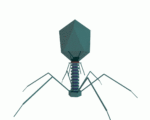 Viruses are infectious particles that stand on the border between life and non-life. Like organisms, viruses have genes, giving them one of the key properties of life: genetic instructions for self-replication. At the same time, viruses lack many of life’s other key properties: they’re not made of cells; they lack any independent metabolism, and they can’t reproduce on their own.
Viruses are infectious particles that stand on the border between life and non-life. Like organisms, viruses have genes, giving them one of the key properties of life: genetic instructions for self-replication. At the same time, viruses lack many of life’s other key properties: they’re not made of cells; they lack any independent metabolism, and they can’t reproduce on their own.
Viruses are best described as obligate intracellular parasites, a phrase worth taking apart.
- Parasites are organisms that interact closely with a larger host organism, causing their host harm. While viruses don’t qualify as organisms (an organism is an independent living thing), they certainly prey on a larger host, causing it harm. That host, in some cases, is us. Every time you’ve had a cold, the flu, or another viral infection, you’ve been parasitized by a virus. The COVID-19 pandemic (as we discuss in the next tutorial) was caused by a virus.
- Obligate means “by necessity.” Viruses can’t live on their own. The only way they reproduce themselves is by parasitizing a living cell.
- Intracellular means “within cells.” Viruses are the smallest parasites imaginable, preying upon life at its most basic level: the cell.
While COVID-19 has alerted most people to the importance of viruses, most people aren’t aware of how ubiquitous viruses are. It’s thought that each of Earth’s 9 million or so species is preyed upon by one or more viruses National Library of Medicine. Humans alone might host over 1000 viruses (over 200 of which have been identified so far). A study at UC Santa Barbara estimated that every liter of seawater might have ten million bacteriophages (viruses that attack bacteria). National Geographic has reported that there might be 1031 viruses on planet Earth. That means that there are many more viruses than stars in the universe.
So let’s see how these obligate intracellular parasites work. If it suits your learning style, you can start by viewing my music video, I’m a Virus!(below on this page). Otherwise, continue reading below.
2. Viruses: Size and Structure
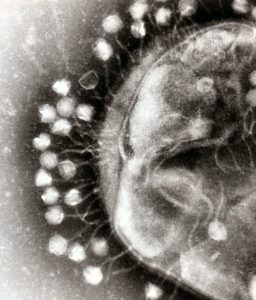
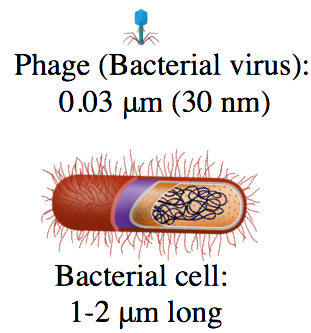
Viruses are phenomenally small. The image to the left shows a type of virus called a bacteriophage (or just phage) attacking a bacterial cell. On the right, you can see an illustrated comparison of a single bacteriophage and a bacterial cell. Note that the numbers are right, but that visually, the virus should be much smaller. Just to connect the smallness of viruses to the biology that you already know, think of this: A DNA molecule is about 2 nanometers wide. A virus is only about 15 times bigger than that. When we talk about viruses, we’re practically at a molecular scale

In terms of structure, viruses are much simpler than cells. To the left, you can see an artist’s depiction of the bacterial viruses that are shown above. These bacterial viruses consist of two main parts: a genetic core (1), consisting of DNA or RNA; and a protein coat (2), also known as a capsid. The capsid, in turn, is made of self-assembling units called capsomeres.
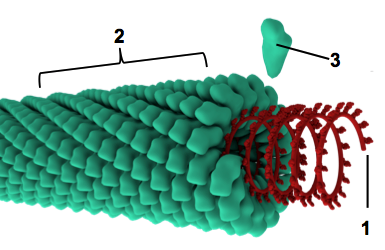
On the right, you can see another type of virus, with the same numbering scheme used to indicate the genetic core (1) and the capsid/protein coat (2). An individual capsomere subunit is at “3.” Note that if the capsomere/capsid relationship is making you think about the tertiary and quaternary levels of structure in proteins, you’ve learned a lot about biology. Good job!

In addition to the capsid, there can also be other protein parts. I’ve always thought that bacteriophages look similar to NASA’s lunar module, the ship in which the Apollo astronauts landed on the moon during the Apollo program in the 1960s and 70s. As you can see in the diagram of the bacteriophage above and on the left, this bacteriophage has, on its bottom, what looks like landing gear, and that’s exactly what it is: proteins for attaching to the cells that these viruses parasitize.
Along with landing gear, viruses have various mechanisms for injecting their genes through a cell’s membrane and/or wall, as well as a few other enzymes that the virus will make use of as it attacks its victims.
3. The Lytic Cycle
While viruses aren’t alive, their replication cycle is often referred to as a life cycle. The simplest viral life cycle is called the lytic cycle. In your studies of biology, you’ve met the root lyse several times in words like hydrolysis and lysosome. Hydrolysis is a process in which molecules are broken apart. Lysosomes are organelles that enable cells to digest engulfed food particles (or even organisms). What do you think the lytic cycle breaks apart?
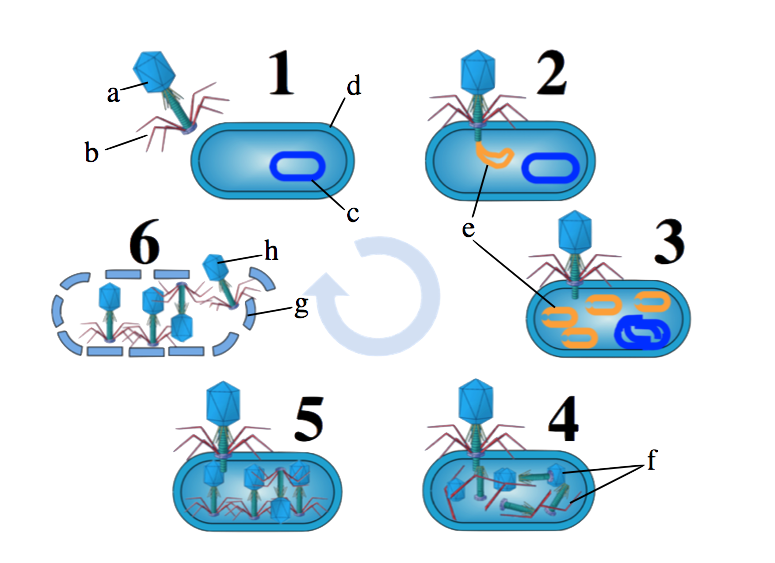 Here’s the lytic cycle for a bacteriophage(or “phage”). As discussed above, that’s the name for a virus that attacks a bacterial cell.
Here’s the lytic cycle for a bacteriophage(or “phage”). As discussed above, that’s the name for a virus that attacks a bacterial cell.
- The cycle begins with a phage (“a”) randomly bumping into its host. Proteins on the phage (the “landing gear” at “b”) enable it to attach to the wall (“d”) of its bacterial host. The host cell’s chromosome is shown at “c.”
- The phage injects its DNA (“e”) into its victim.
- The phage then uses the host cell’s molecular machinery (such as DNA polymerases) to copy the phage’s DNA, while simultaneously shutting down the host cell’s DNA.
- The host’s RNA polymerases and ribosomes are used to create new phage components.
- Based on molecular complementarity, these phage components assemble themselves into new viruses.
- At a certain point, the host is so stuffed with phages that it bursts, releasing new phages into the environment.
As shown above, the lytic cycle is found in some bacteriophages (others have a more complex life cycle, which we’ll discuss below). Other lytic viruses include the Ebola virus and SARS-CoV-2.
4. Quiz: Viruses and the Lytic Cycle
[qwiz qrecord_id=”sciencemusicvideosMeister1961-viruses and the lytic cycle (v2.0)”]
[h]Viruses and the Lytic Cycle (labeled diagram quiz)
[i]
[q labels = “right”]
[l]genes (DNA or RNA)
[fx] No. Please try again.
[f*] Correct!
[l]protein
[fx] No. Please try again.
[f*] Excellent!
[q labels = “top”]
[l]genes
[fx] No. Please try again.
[f*] Correct!
[l]capsid
[fx] No, that’s not correct. Please try again.
[f*] Correct!
[l]capsomere
[fx] No. Please try again.
[f*] Great!
[q labels = “top”]
[l]attachment
[fx] No. Please try again.
[f*] Excellent!
[l]injection of viral DNA
[fx] No, that’s not correct. Please try again.
[f*] Good!
[l]lysis
[fx] No. Please try again.
[f*] Good!
[l]replication of viral DNA
[fx] No. Please try again.
[f*] Excellent!
[l]self-assembly of new viruses
[fx] No, that’s not correct. Please try again.
[f*] Excellent!
[l]synthesis of viral proteins
[fx] No. Please try again.
[f*] Correct!
[/qwiz]
5. The Lysogenic Cycle

In the lysogenic cycle, viral genes incorporate themselves into the chromosomes of their hosts. As you can see in image 1 (on the upper right side of the diagram to your left), the cycle begins just as the lytic cycle does: with the virus (B) injecting its genes (C) into its host (D).
But in step two, things start to differ. Here, the viral DNA (in red) incorporates itself into its host’s chromosome (at “E,” in blue). Once there, the viral DNA is called a provirus (or a prophage, if it’s a bacterial virus).
From this point on, as you can see in part II of the diagram (images 3, 4, and 5) the provirus becomes part of (and benefits from) the host cell’s reproductive cycle. In other words, every time the cell replicates itself, the cell will also replicate the provirus. Since bacteria can reproduce themselves very quickly (E. coli can reproduce itself every 20 minutes under ideal conditions), lysogenic incorporation can be an effective reproductive strategy for lysogenic viruses.
At certain moments, however, proviruses can break out of their dormancy, excise themselves from their host chromosome, and re-enter the virulent, lytic cycle. It’s possible that certain environmental stimuli, such as exposure to ultraviolet light, induce this change Encyclopedia Britannica. The consequences of this break-out are seen in the top half of the diagram: in # 6, viral genes are synthesized. In # 7, viral proteins are translated. In # 8, self-assembly of viral parts occurs, leading to lysis in step 9.
Some viruses that infect humans and other eukaryotes have life cycles that can be described as lysogenic. A well-known example is the herpes virus, which inserts its DNA into its host cells.
Continue by answering the questions below.
[qwiz qrecord_id=”sciencemusicvideosMeister1961-Lysogenic cycle (v2.0)”]
[h] The Lysogenic Cycle: Interactive Diagram
[q labels = “top”]
[l]binary fission
[f*] Good!
[fx] No, that’s not correct. Please try again.
[l]provirus break out: production of viral DNA
[f*] Correct!
[fx] No. Please try again.
[l]DNA replication, including phage DNA
[f*] Excellent!
[fx] No. Please try again.
[l]injection of viral genes
[f*] Excellent!
[fx] No. Please try again.
[l]incorporation of phage DNA into host chromosome
[f*] Good!
[fx] No. Please try again.
[l]lysis
[f*] Correct!
[fx] No. Please try again.
[l]production of viral proteins
[f*] Great!
[fx] No. Please try again.
[l]self-assembly of new viruses
[f*] Excellent!
[fx] No. Please try again.
[q] The diagram below shows a virus with a [hangman] reproduction cycle. This is shown by the way the virus incorporates its [hangman] into its hosts [hangman]
[c]IGx5c29nZW5pYw==[Qq]
[f]IEV4Y2VsbGVudCE=[Qq]
[c]IGdlbmVz[Qq]
[f]IEdyZWF0IQ==[Qq]
[c]IGNocm9tb3NvbWU=[Qq]
[f]IEV4Y2VsbGVudCE=[Qq]
[q] In the diagram below, which letter shows a prophage?
[textentry single_char=”true”]
[c]IE M=[Qq]
[f]IE5pY2Ugam9iLiAmIzgyMjA7QyYjODIyMTsgc2hvd3MgdmlyYWwgRE5BIGluY29ycG9yYXRlZCBpbnRvIHRoZSBob3N0IGNocm9tb3NvbWUuIEluIG90aGVyIHdvcmRzLCBhIHByb3BoYWdlLg==[Qq]
[c]ICo=[Qq]
[f]IE5vLiBGaW5kIHZpcmFsIEROQSB0aGF0JiM4MjE3O3MgaW5jb3Jwb3JhdGVkIGl0c2VsZiBpbnRvIHRoZSBob3N0JiM4MjE3O3MgY2hyb21vc29tZS4=[Qq]
[q] In the diagram below, which number shows how the virus exploits the host’s replication cycle?
[textentry single_char=”true”]
[c]ID Q=[Qq]
[f]IEF3ZXNvbWUuICYjODIyMDs0JiM4MjIxOyBzaG93cyBob3cgb25jZSBhIHZpcnVzIGhhcyBpbmNvcnBvcmF0ZWQgaW50byBpdHMgaG9zdCwgaXQgZ2V0cyByZXByb2R1Y2VkIGV2ZXJ5IHRpbWUgdGhlIGhvc3QgcmVwcm9kdWNlcyBpdHNlbGYu[Qq]
[c]ICo=[Qq]
[f]IE5vLiBPbmUgb2YgdGhlIGJpZyBiZW5lZml0cyBvZiBiZWluZyBseXNvZ2VuaWMgZXZlcnkgdGltZSB0aGUgaG9zdCByZXByb2R1Y2VzLCB0aGUgZ2VuZXRpYyBtYXRlcmlhbCBvZiB0aGUgdmlydXMgYWxzbyBnZXRzIHJlcHJvZHVjZWQuIFdoaWNoIG51bWJlciBzaG93cyB0aGlzPw==[Qq]
[q] In the diagram below, which letter shows the viral capsid?
[textentry single_char=”true”]
[c]IE Q=[Qq]
[f]IEdyZWF0IGpvYi4gJiM4MjIwO0QmIzgyMjE7IHNob3dzIHRoZSBjYXBzaWQgdGhhdCB3aWxsIHNvb24gc3Vycm91bmQgdGhlIHZpcnVzJiM4MjE3O3MgZ2VuZXMu[Qq]
[c]ICo=[Qq]
[f]IE5vLiBIZXJlJiM4MjE3O3MgYSBoaW50OiB0aGUgY2Fwc2lkIHN1cnJvdW5kcyB0aGUgdmlydXMmIzgyMTc7cyBnZW5ldGljIG1hdGVyaWFsLg==[Qq]
[x]
[restart]
[/qwiz]
6. HIV: Structure and Life Cycle
“HIV” is an acronym for Human Immunodeficiency Virus. Infection with HIV, if untreated, causes AIDS: acquired immunodeficiency syndrome. Let’s look at that term:
- Acquired: you have to be infected with the virus to get AIDS. In other words, unlike some other disorders of the immune system, it’s not inherited.
- Immunodeficiency. Your immune system is how your body fights off invading disease-causing organisms such as bacteria or fungi, as well as viruses. If you’re immunodeficient, you lack all or some of your body’s capacity to fight off these invaders.
Here’s a description of how HIV causes AIDS from HIV.gov
HIV attacks the body’s immune system, specifically the CD4 cells (T cells), which help the immune system fight off infections. If left untreated, HIV reduces the number of CD4 cells (T cells) in the body, making the person more likely to get infections or infection-related cancers. Over time, HIV can destroy so many of these cells that the body can’t fight off infections and diseases. These opportunistic infections or cancers take advantage of a very weak immune system and signal that the person has AIDS, the last state of HIV infection.
In terms of our AP Biology course, one of the key things to understand about HIV is that it’s a retrovirus. Retroviruses have RNA genes, and then use an enzyme called reverse transcriptase to make a DNA transcript of their RNA. Note that this is the opposite of what usually happens during transcription, during which DNA is transcribed into RNA: that’s why this is reverse transcription, and why HIV is a retrovirus. This DNA then lysogenizes, entering into the nuclear DNA of its host, the helper T cell.
Let’s start by looking at the key parts of HIV’s structure, and then we’ll go through its life cycle.
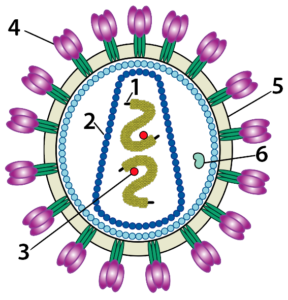
“1” is HIV’s RNA genome. Note that every particle of HIV has two identical RNA genomes. Surrounding the genes (at “2”) is a capsid. “3” is reverse transcriptase, the enzyme whose function we described above. “4” indicates the glycoproteins (proteins with an attached carbohydrate) that enable HIV to bind with and inject its genes and enzymes into its host. These glycoproteins are embedded in a phospholipid bilayer (“5”). As we’ll see below, these phospholipids are stolen from the infected helper T cell as HIV oozes out of its victim in a process that closely resembles exocytosis. “6” is another enzyme called “protease.” Protease modifies some of the viral polypeptides that HIV forces its host to synthesize, creating mature viral proteins that can be assembled into new viruses.
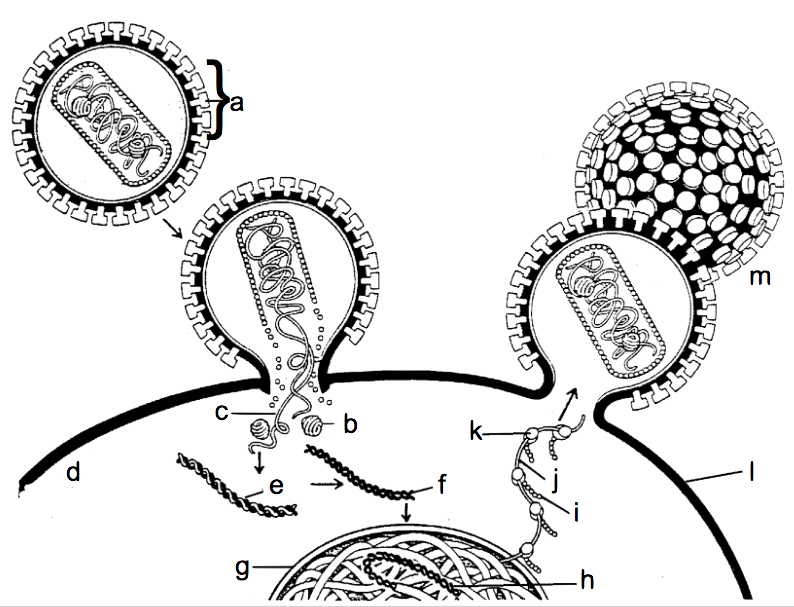
Let’s now look at HIV’s life cycle.
The letter “a” represents HIV in an infected person’s bloodstream. The glycoproteins on HIV’s surface enable it to bind with membrane proteins on the surface of HIV’s target, the Helper T cell (“d”). Binding leads to the fusion of HIV with the Helper T, allowing viral RNA (“c”) and reverse transcriptase (“b”) to enter the cell.
The function of reverse transcriptase is to convert the information in HIV’s RNA into DNA. Using HIV’s RNA as a template, reverse transcriptase creates a hybrid DNA/RNA molecule (shown at “e”), which is then converted into a molecule that is purely viral DNA (at “f”). This viral DNA then enters the Helper T cell’s nucleus (“g”), where it becomes incorporated into the T cell’s chromosomal DNA as a provirus (“H”). Once in the nucleus, HIV’s DNA will be transcribed into RNA (“j”). The cell’s ribosomes (“k”) will translate the viral RNA into viral proteins (“i”), which will self-assemble into new viruses (“m”) that bud off from the helper T cell’s membrane (“l”), to be released into the blood or lymph.
Not shown in the life cycle diagram above is the role of an enzyme called protease. As mentioned above, as HIV directs its host to synthesize viral proteins, protease modifies some of these proteins to create a mature virus capable of infecting other T cells. If you’ve heard of drugs called “protease inhibitors,” you now can probably infer that their function is to keep HIV from maturing into an infectious virus.
Other anti-HIV drugs inhibit other HIV enzymes or proteins. One well-known drug is AZT, which inhibits reverse transcriptase, preventing it from reverse transcribing HIV’s RNA into DNA. Click here to read more about AZT on Britannica.com. Other drugs prevent HIV’s glycoproteins from binding with a membrane protein on the surface of the Helper T cell, which prevents HIV from fusing with the Helper T cell.
In all cases, these drugs have to be used in combination with one another: otherwise, HIV’s high mutation rate will allow it to evolve variants that are resistant to any one (or even two) drugs, allowing the infection to resume its course.
[qwiz style=”width: 600px !important; min-height: 400px !important;” qrecord_id=”sciencemusicvideosMeister1961-HIV (v2.0)”]
[h] HIV: Interactive Diagrams
[i]
[q labels = “top”]
[l]capsid
[f*] Great!
[fx] No, that’s not correct. Please try again.
[l]glycoprotein
[f*] Excellent!
[fx] No. Please try again.
[l]phospholipid bilayer
[f*] Good!
[fx] No. Please try again.
[l]protease
[f*] Good!
[fx] No. Please try again.
[l]reverse transcriptase
[f*] Excellent!
[fx] No, that’s not correct. Please try again.
[l]RNA
[f*] Correct!
[fx] No. Please try again.
[q labels = “top”]
[l]docks with Helper T cell
[f*] Good!
[fx] No. Please try again.
[l]genes
[f*] Great!
[fx] No. Please try again.
[l]makes DNA from RNA
[f*] Good!
[fx] No. Please try again.
[l]modifies HIV proteins
[f*] Good!
[fx] No. Please try again.
[l]protein coat
[f*] Excellent!
[fx] No, that’s not correct. Please try again.
[l]stolen from the host cell membrane
[f*] Excellent!
[fx] No. Please try again.
[q labels = “top”]
[l]Helper T membrane
[f*] Correct!
[fx] No, that’s not correct. Please try again.
[l]HIV Glycoprotein
[f*] Good!
[fx] No. Please try again.
[l]hybrid viral DNA-RNA
[f*] Correct!
[fx] No, that’s not correct. Please try again.
[l]nucleus
[f*] Good!
[fx] No, that’s not correct. Please try again.
[l]provirus
[f*] Good!
[fx] No, that’s not correct. Please try again.
[l]reverse transcriptase
[f*] Correct!
[fx] No. Please try again.
[l]viral RNA
[f*] Correct!
[fx] No. Please try again.
[l]viral protein
[f*] Excellent!
[fx] No. Please try again.
[l]new virus
[f*] Correct!
[fx] No, that’s not correct. Please try again.
[l]viral DNA
[f*] Correct!
[fx] No, that’s not correct. Please try again.
[q] In the diagram below, which letter shows hybrid viral DNA/RNA?
[textentry single_char=”true”]
[c]IG U=[Qq]
[f]IE5pY2Ugam9iLiBMZXR0ZXIgJiM4MjIwO2UmIzgyMjE7IHNob3dzIEROQSB0aGF0JiM4MjE3O3MgYm91bmQgdG8gdmlyYWwgUk5BLCBjcmVhdGluZyBhIGh5YnJpZCBETkEvUk5BLg==[Qq]
[c]ICo=[Qq]
[f]IE5vLiBIZXJlJiM4MjE3O3MgYSBoaW50LiAmIzgyMjA7QyYjODIyMTsgaXMgdmlyYWwgUk5BLCBhbmQgJiM4MjIwO0ImIzgyMjE7IGlzIHJldmVyc2UgdHJhbnNjcmlwdGFzZS4gV2hhdCBsZXR0ZXIgc2hvd3Mgd2hhdCByZXZlcnNlIHRyYW5zY3JpcHRhc2UgbWFrZXM/[Qq]
[q] In the diagram below, which letter shows a ribosome?
[textentry single_char=”true”]
[c]IG s=[Qq]
[f]IEdyZWF0IGpvYi4gTGV0dGVyICYjODIyMDtrJiM4MjIxOyBpcyBhIHJpYm9zb21lLCB0cmFuc2NyaWJpbmcgdmlyYWwgUk5BIGludG8gdmlyYWwgcHJvdGVpbi4=[Qq]
[c]ICo=[Qq]
[f]IE5vLiBIZXJlJiM4MjE3O3MgYSBoaW50LiBMZXRlciAmIzgyMjA7aSYjODIyMTsgcmVwcmVzZW50cyBhIHZpcmFsIHBvbHlwZXB0aWRlLCBhbmQgbGV0dGVyICYjODIyMDtqJiM4MjIxOyByZXByZXNlbnRzIHZpcmFsIFJOQS4gV2hhdCYjODIxNztzIHRyYW5zbGF0aW5nIHRoYXQgUk5BIGludG8gYSBwb2x5cGVwdGlkZT8=[Qq]
[q] In the diagram below, a provirus is at letter…
[textentry single_char=”true”]
[c]IG g=[Qq]
[f]IE5pY2Ugam9iLiBMZXR0ZXIgJiM4MjIwO2gmIzgyMjE7IHNob3dzIGEgcHJvdmlydXM6IHZpcmFsIEROQSB0aGF0JiM4MjE3O3MgYmVlbiBpbmNvcnBvcmF0ZWQgaW50byBpdHMgaG9zdCYjODIxNztzIEROQS4=[Qq]
[c]ICo=[Qq]
[f]IE5vLiBIZXJlJiM4MjE3O3MgYSBoaW50LiAmIzgyMjA7RiYjODIyMTsgaXMgdmlyYWwgRE5BIG91dHNpZGUgdGhlIG51Y2xldXMuIFdoaWNoIGxldHRlciBzaG93cyB0aGF0IHNhbWUgRE5BIGluc2lkZSB0aGUgbnVjbGV1cywgaW5jb3Jwb3JhdGVkIGludG8gaXRzIGhvc3QmIzgyMTc7cyBETkE/[Qq]
[q multiple_choice=”true”] You read above that drugs like AZT work against reverse transcriptase. If a person who was infected with HIV took AZT, then the virus’s replication cycle would end
[c]YmVjYXVzZSB0aGUgdmlydXMgd291bGQgbm8gbG9uZ2VyIGJlIGFibGUgdG8gZnVzZSB3aXRoIGl0cyB0YXJnZXQgY2VsbC4=[Qq]
[f]Tm8uIEFaVCBibG9ja3MgcmV2ZXJzZSB0cmFuc2NyaXB0YXNlLiBUaGUgdmlydXMgd291bGQgc3RpbGwgYmUgYWJsZSB0byBlbnRlciB0aGUgY2VsbA==[Qq]
[c]anVzdCBiZWZvcmUgdGhlIGh5YnJpZCBETkEvUk5BIG F0ICYjODIyMDtlJiM4MjIxOyBpcyBjcmVhdGVkLg==[Qq]
[f]IEV4YWN0bHkuIFJldmVyc2UgdHJhbnNjcmlwdGFzZSB0YWtlcyB2aXJhbCBSTkEgYW5kIG1ha2VzIGl0IGludG8gRE5BLiBCbG9ja2luZyByZXZlcnNlIHRyYW5zY3JpcHRhc2UgKGIpIHdvdWxkIHByZXZlbnQgdGhlIGZvcm1hdGlvbiBvZiBoeWJyaWQgRE5BL1JOQS4=[Qq]
[c]YmVjYXVzZSB0aGUgdmlydXMgY291bGQgbm8gbG9uZ2VyIGVudGVyIGludG8gaXRzIGhvc3QmIzgyMTc7cyBudWNsZXVzLg==[Qq]
[f]Tm8uIFdoaWxlIHRoYXQmIzgyMTc7cyB0cnVlLCB0aGUgY3ljbGUgd291bGQgZW5kIGV2ZW4gZWFybGllciwgd2hlbiByZXZlcnNlIHRyYW5zY3JpcHRhc2UgKGF0IGIpIG1ha2VzIHZpcmFsIFJOQSAoYykgaW50byBETkEu[Qq]
[c]YmVjYXVzZSB0aGUgY2VsbCB3b3VsZCBubyBsb25nZXIgYmUgJiM4MjIwO3RyaWNrZWQmIzgyMjE7IGludG8gbWFraW5nIHZpcmFsIFJOQSBhbmQgcHJvdGVpbnMu[Qq]
[f]Tm8uIFdoaWxlIHRoYXQmIzgyMTc7cyB0cnVlLCB0aGUgY3ljbGUgd291bGQgZW5kIGV2ZW4gZWFybGllciwgd2hlbiByZXZlcnNlIHRyYW5zY3JpcHRhc2UgKGF0IGIpIG1ha2VzIHZpcmFsIFJOQSAoYykgaW50byBETkEu[Qq]
[/qwiz]
7. I’m a Virus (Music Video)
Most of what you learned above is captured in the music video below. Enjoy!
8. Viruses: Cumulative Quiz
[qwiz qrecord_id=”sciencemusicvideosMeister1961-Viruses, Cumulative (v2.0)” random=”true”]
[h] Virus Cumulative Quiz
[i]
[q xx=”1″ json=”true” dataset_id=”Viruses Dataset|6f3ed8e8b1ebc” question_number=”1″] The diagram below shows a type of virus known as a [hangman]. When this virus attacks its host, it will inject its [hangman] (at “1”). The structure at “2” is known as a [hangman].
[c]YmFjdGVyaW9waGFnZQ==[Qq]
[c]Z2VuZXM=[Qq]
[c]Y2Fwc2lk[Qq]
[q xx=”1″ json=”true” dataset_id=”Viruses Dataset|6f30bb609babc” question_number=”4″] The structure at “3” is a [hangman].
[c]Y2Fwc29tZXJl
Cg==[Qq]
[q xx=”1″ json=”true” dataset_id=”Viruses Dataset|6f20248be32bc” question_number=”7″] Which number is pointing to the moment when the virus first injects its genetic material?
[textentry single_char=”true”]
[c]ID I=[Qq]
[f]IFllcy4g4oCcMuKAncKgaW5kaWNhdGVzIHRoZSBtb21lbnQgd2hlbiB0aGUgdmlydXMgZmlyc3QgaW5qZWN0cyBpdHMgZ2VuZXRpYyBtYXRlcmlhbC4=[Qq]
[c]ICo=[Qq]
[f]IE5vLiBIZXJlJiM4MjE3O3MgYSBoaW50LsKgVGhlIGdlbmV0aWMgbWF0ZXJpYWwgaXMgc2hvd24gYXQgbGV0dGVyICYjODIyMDtlLiYjODIyMTsgV2hlbiBpcyBpdCBmaXJzdCBiZWluZyBpbmplY3RlZCBpbnRvIHRoZSBob3N0IGNlbGw/
Cg==[Qq]
[q xx=”1″ json=”true” dataset_id=”Viruses Dataset|6f1b0cb1e06bc” question_number=”8″] Which number is pointing to the moment when the virus’s genetic material is being replicated, while at the same time the host’s chromosome is disintegrating?
[textentry single_char=”true”]
[c]ID M=[Qq]
[f]IFllcy4g4oCcM+KAncKgaW5kaWNhdGVzIHRoZSBtb21lbnTCoHdoZW4gdGhlIHZpcnVzJiM4MjE3O3MgZ2VuZXRpYyBtYXRlcmlhbCBpcyBiZWluZyByZXBsaWNhdGVkLCBhbmQgd2hlbiB0aGUgaG9zdCYjODIxNztzIGNocm9tb3NvbWUgaXMgZGlzaW50ZWdyYXRpbmcu[Qq]
[c]ICo=[Qq]
[f]IE5vLiBIZXJlJiM4MjE3O3MgYSBoaW50LsKgVGhlIHZpcnVzJiM4MjE3O3MgZ2VuZXRpYyBtYXRlcmlhbCBpcyBzaG93biBhdCBsZXR0ZXIgJiM4MjIwO2UuJiM4MjIxOyBXaGVuIGlzIGl0IGJlaW5nIG1hZGUgaW50byBtYW55IGNvcGllcyAoYSBwcm9jZXNzIGtub3duIGFzICYjODIyMDtyZXBsaWNhdGlvbiYjODIyMTspPw==
Cg==[Qq]
[q xx=”1″ json=”true” dataset_id=”Viruses Dataset|6f163f595a2bc” question_number=”9″] Which number is pointing to the moment when viral proteins are being constructed?
[textentry single_char=”true”]
[c]ID Q=[Qq]
[f]IFllcy4g4oCcNOKAnSBzaG93cyBuZXcgdmlydXMgcGllY2VzIGJlaW5nIGFzc2VtYmxlZC4gVGhpcyBvY2N1cnMgYXMgdGhlIHZpcnVzIHVzZXMgdGhlIGhvc3QmIzgyMTc7cyBtYWNoaW5lcnkgKHBvbHltZXJhc2VzIGFuZCByaWJvc29tZXMpIHRvIGNyZWF0ZSBuZXcgdmlyYWwgZ2VuZXMgYW5kIHByb3RlaW5zLg==[Qq]
[c]ICo=[Qq]
[f]IE5vLiBIZXJlJiM4MjE3O3MgYSBoaW50LsKgTmV3IHZpcmFsIHBpZWNlcyBhcmUgc2hvd24gYXQgbGV0dGVyICYjODIyMDtmLiYjODIyMTs=
Cg==[Qq]
[q xx=”1″ json=”true” dataset_id=”Viruses Dataset|6f11023e992bc” question_number=”10″] Which number indicates virus self-assembly?
[textentry single_char=”true”]
[c]ID U=[Qq]
[f]IFllcy4g4oCcNeKAnSBzaG93cyBuZXcgdmlydXNlcyBzZWxmLWFzc2VtYmxpbmcu[Qq]
[c]ICo=[Qq]
[f]IE5vLiBIZXJlJiM4MjE3O3MgYSBoaW50LsKgTG9vayBhdCB0aGUgY2VsbHMgaW4gdGhpcyB0aW1lLXNlcXVlbmNlLiBXaGVyZSBkbyB5b3Ugc2VlIG9uZSBzdGlsbC1pbnRhY3QgY2VsbCB3aXRoIG1hbnkgdmlydXNlcyBzdHVmZmVkIGluc2lkZT8=
Cg==[Qq]
[q xx=”1″ json=”true” dataset_id=”Viruses Dataset|6f0ca4a84dabc” question_number=”11″] Which number indicates lysis?
[textentry single_char=”true”]
[c]ID Y=[Qq]
[f]IFllcy4g4oCcNuKAnSBzaG93cyBseXNpczogdGhlIGJ1cnN0aW5nIG9mIHRoZSBob3N0IGNlbGwgYW5kIGVzY2FwZSBvZiBuZXcgdmlydXNlcy4=[Qq]
[c]ICo=[Qq]
[f]IE5vLsKgTHlzaXMgaXMgd2hlbiB0aGUgY2VsbCBidXJzdHMgYW5kIHJlbGVhc2VzIG5ldyB2aXJ1c2VzLiBXaGVyZSBkbyB5b3Ugc2VlIHRoYXQgaGFwcGVuaW5nPw==
Cg==[Qq]
[q xx=”1″ json=”true” dataset_id=”Viruses Dataset|6f07fc9085abc” question_number=”12″] Which letter indicates the host cell’s chromosome?
[textentry single_char=”true”]
[c]IG M=[Qq]
[f]IFllcy4g4oCcY+KAnSBpbmRpY2F0ZXMgdGhlIGhvc3QgY2VsbCYjODIxNztzIGNocm9tb3NvbWUu[Qq]
[c]ICo=[Qq]
[f]IE5vLiBIZXJlJiM4MjE3O3MgYSBoaW50LiBJZiB0aGUgaG9zdCBjZWxsJiM4MjE3O3Mgd2FsbCBhbmQgbWVtYnJhbmUgYXJlIGluZGljYXRlZCBieSAmIzgyMjA7ZCwmIzgyMjE7IHdoYXQgbGV0dGVyIHdvdWxkIGhhdmUgdG8gYmUgdGhlIGhvc3QgY2VsbCYjODIxNztzIGNocm9tb3NvbWU/
Cg==[Qq]
[q xx=”1″ json=”true” dataset_id=”Viruses Dataset|6f035478bdabc” question_number=”13″] Which letter indicates the host cell’s disintegrating membrane and wall?
[textentry single_char=”true”]
[c]IG c=[Qq]
[f]IFllcy4g4oCcZ+KAnSBpbmRpY2F0ZXMgdGhlIGhvc3QgY2VsbCYjODIxNztzIGRpc2ludGVncmF0aW5nIG1lbWJyYW5lIGFuZCB3YWxsLg==[Qq]
[c]ICo=[Qq]
[f]IE5vLiBIZXJlJiM4MjE3O3MgYSBoaW50LiA=Rmlyc3Qgb2YgYWxsLCBsb29rIGZvciBhIGxldHRlci7CoA==IExvb2sgYXQgZGlhZ3JhbSAmIzgyMjA7MS4mIzgyMjE7IExldHRlciAmIzgyMjA7ZCYjODIyMTsgc2hvd3MgYW4gaW50YWN0IG1lbWJyYW5lIGFuZCB3YWxsLiBOb3cgZm9sbG93IHRoZSB0aW1lIHNlcXVlbmNlIHVudGlsIHlvdSBzZWUgdGhhdCBzYW1lIG1lbWJyYW5lIGFuZCB3YWxsIGRpc2ludGVncmF0aW5nIGFzIHRoZSBjZWxsIGdvZXMgdGhyb3VnaCBseXNpcy4=
Cg==[Qq]
[q xx=”1″ json=”true” dataset_id=”Viruses Dataset|6efed1a1b3ebc” question_number=”14″] Which letter indicates the virus’s tail fibers, with proteins that can bind to the host cell’s wall or membrane?
[textentry single_char=”true”]
[c]IG I=[Qq]
[f]IFllcy4g4oCcYuKAnSBpbmRpY2F0ZXMgdGhlIHZpcnVzJiM4MjE3O3MgdGFpbCBmaWJlcnMu[Qq]
[c]ICo=[Qq]
[f]IE5vLiBIZXJlJiM4MjE3O3MgYSBoaW50LsKgTG9vayBhdCBkaWFncmFtICYjODIyMDsxLiYjODIyMTvCoFdoaWNoIGlzIHRoZSBvbmx5IHBhcnQgb2YgdGhlIGluY29taW5nIHZpcnVzIHRoYXQgY291bGQgYmUgdGhlIHRhaWwgZmliZXJzPw==
Cg==[Qq]
[q xx=”1″ json=”true” dataset_id=”Viruses Dataset|6efa4ecaaa2bc” question_number=”15″] Which number shows the step where the virus is injecting its genetic material into its victim?
[textentry single_char=”true”]
[c]ID E=[Qq]
[f]IFllcy4g4oCcMeKAnSBzaG93cyB0aGUgdmlydXMgaW5qZWN0aW5nIGl0cyBnZW5ldGljIG1hdGVyaWFsIGludG8gaXRzIHZpY3RpbQ==[Qq]
[c]ICo=[Qq]
[f]IE5vLsKgSGVyZSYjODIxNztzIGEgaGludC4gVGhlIHZpcnVzJiM4MjE3O3MgZ2VuZXRpYyBtYXRlcmlhbCBpcyBzaG93biBpbiByZWQuIFdoZXJlIGlzIGl0IGZpcnN0IGVudGVyaW5nIHRoZSBjZWxsIHRoYXQgdGhlIHZpcnVzIGluIGluZmVjdGluZz8=
Cg==[Qq]
[q xx=”1″ json=”true” dataset_id=”Viruses Dataset|6ef5a6b2e22bc” question_number=”16″] Which number shows the step where the virus’s genetic material is first integrating into the host chromosome?
[textentry single_char=”true”]
[c]ID I=[Qq]
[f]IFllcy4g4oCcMuKAnSBzaG93cyB0aGUgdmlydXMmIzgyMTc7cyBnZW5ldGljIG1hdGVyaWFsIGludGVncmF0aW5nIGludG8gdGhlIGhvc3QgY2hyb21vc29tZS4=[Qq]
[c]ICo=[Qq]
[f]IE5vLsKgSGVyZSYjODIxNztzIGEgaGludC4gVGhlIHZpcnVzJiM4MjE3O3MgZ2VuZXRpYyBtYXRlcmlhbCBpcyBzaG93biBpbiByZWQuIFdoZXJlIGlzIGl0wqBpbnRlZ3JhdGluZyBpbnRvIHRoZSBob3N0IGNocm9tb3NvbWU/
Cg==[Qq]
[q xx=”1″ json=”true” dataset_id=”Viruses Dataset|6eef3f922f2bc” question_number=”17″] Which number shows the step where the host’s replication machinery is starting to replicate the host cell chromosome, along with the DNA of the virus?
[textentry single_char=”true”]
[c]ID M=[Qq]
[f]IFllcy4g4oCcM+KAnSBzaG93cyB0aGUgaG9zdCBjZWxsIHJlcGxpY2F0aW5nIGl0cyBjaHJvbW9zb21lLCBhcyB3ZWxsIGFzIHRoZSBwcm92aXJ1cyB0aGF0IGhhcyBiZWVuIGluc2VydGVkIGludG8gdGhlIGNocm9tb3NvbWUu[Qq]
[c]ICo=[Qq]
[f]IE5vLsKgSGVyZSYjODIxNztzIGEgaGludC4gVGhlIGhvc3QgY2VsbCYjODIxNztzIGNocm9tb3NvbWUgd2FzIG9yaWdpbmFsbHkgc2hvd24gYXMgbGV0dGVyICYjODIyMDtFJiM4MjIxOyBpbiBkaWFncmFtICYjODIyMDsxLiYjODIyMTvCoFdoZXJlIGRvIHlvdSBzZWUgdGhhdCBjaHJvbW9zb21lIChhbG9uZyB3aXRoIHZpcmFsIEROQSB0aGF0IGhhcyBpbnRlZ3JhdGVkIGluc2lkZSB0aGUgaG9zdCBjZWxsJiM4MjE3O3MgY2hyb21vc29tZSksIHN0YXJ0aW5nIHRvIGJlIHJlcGxpY2F0ZWQ/
Cg==[Qq]
[q xx=”1″ json=”true” dataset_id=”Viruses Dataset|6eea02776e2bc” question_number=”18″] Which letter shows a prophage or provirus?
[textentry single_char=”true”]
[c]IE Y=[Qq]
[f]IFllcy4g4oCcRuKAnSBzaG93cyBhIHByb3BoYWdlIG9yIHByb3ZpcnVzLg==[Qq]
[c]ICo=[Qq]
[f]IE5vLsKgSGVyZSYjODIxNztzIGEgaGludC4gVGhlIHByb3BoYWdlIG9yIHByb3ZpcnVzIGlzIHRoZSB2aXJ1cyYjODIxNztzIEROQSAoc2hvd24gaW4gcmVkIGluIGRpYWdyYW0gJiM4MjIwOzEmIzgyMjE7IGludGVncmF0ZWQgaW50byB0aGUgaG9zdCBjaHJvbW9zb21lLg==
Cg==[Qq]
[q xx=”1″ json=”true” dataset_id=”Viruses Dataset|6ee4a01beeebc” question_number=”19″] Which letter shows the virus/phage DNA immediately after it has broken out of the host chromosome?
[textentry single_char=”true”]
[c]IE c=[Qq]
[f]IFllcy4g4oCcR+KAnSBzaG93cyBhIHRoZSBETkEgb2YgdGhlIHBoYWdlIG9yIHZpcnVzIGltbWVkaWF0ZWx5IGFmdGVyIGl0IGhhcyBicm9rZW4gb3V0IG9mIGl0cyBob3N0IGNocm9tb3NvbWUu[Qq]
[c]ICo=[Qq]
[f]IE5vLsKgSGVyZSYjODIxNztzIGEgaGludC7CoEZpbmQgbGV0dGVyICYjODIyMDtGJiM4MjIxOyBpbiBkaWFncmFtICYjODIyMDsyLiYjODIyMTsgV2hlcmUgZG8geW91IHNlZSB0aGUgdmlyYWwgRE5BIGFmdGVyIGl0IGhhcyBsZWZ0IHRoZSBob3N0IGNocm9tb3NvbWUsIGFuZCBzdGFydGVkIHJlcGxpY2F0aW5nIGl0c2VsZi4=
Cg==[Qq]
[q xx=”1″ json=”true” dataset_id=”Viruses Dataset|6edf63012debc” question_number=”20″] Which number shows the step where the host cell is starting to assemble virus/phage proteins?
[textentry single_char=”true”]
[c]ID c=[Qq]
[f]IFllcy4g4oCcN+KAnSBzaG93cyB0aGUgY2VsbCBzdGFydGluZyB0byBhc3NlbWJsZSBhIHZpcmFsIGNhcHNpZCAoc2hvd24gYXQgbGV0dGVyICYjODIyMDtILiYjODIyMTsp[Qq]
[c]ICo=[Qq]
[f]IE5vLsKgSGVyZSYjODIxNztzIGEgaGludC7CoExvb2sgaW4gdGhlIHRvcCBwYXJ0IG9mIHRoZSBkaWFncmFtLCBhbmQgZmluZCB3aGVyZSB0aGUgY2VsbCBpcyBzdGFydGluZyB0byBzeW50aGVzaXplIHZpcmFsIHBpZWNlcywgc3VjaCBhcyB0aGUgY2Fwc2lkIChvciBwcm90ZWluIGNvYXQpLg==
Cg==[Qq]
[q xx=”1″ json=”true” dataset_id=”Viruses Dataset|6eda00a5aeabc” question_number=”21″] Which number shows the step where the host cell is being lysed?
[textentry single_char=”true”]
[c]ID k=[Qq]
[f]IFllcy4g4oCcOeKAnSBzaG93cyB0aGXCoGhvc3QgY2VsbCBiZWluZyBseXNlZCBhcyBpdHMgbWVtYnJhbmUvd2FsbCBicmVha3Mgb3BlbiBhbmQgbmV3IHBoYWdlIGVzY2FwZSBmcm9tIHRoZSBjZWxs[Qq]
[c]ICo=[Qq]
[f]IE5vLsKgSGVyZSYjODIxNztzIGEgaGludC4gTHlzaXMsIGluIHRoZSBjb250ZXh0IG9mIHZpcnVzZXMsIHJlZmVycyB0byB0aGUgY2VsbCYjODIxNztzIGJ1cnN0aW5nIG9wZW4gYW5kIHJlbGVhc2luZyBuZXcgdmlydXNlcy4gV2hlcmUgZG8geW91IHNlZSB0aGF0IGhhcHBlbmluZz8=
Cg==[Qq]
[q xx=”1″ json=”true” dataset_id=”Viruses Dataset|6ed4e8cbabebc” question_number=”22″ multiple_choice=”true”] Which number shows the lysogenic part of the lysogenic cycle?
[c]IEk=[Qq]
[f]IE5vLlRoZSBseXNvZ2VuaWMgcGhhc2UgaXMgd2hlcmUgdGhlIHZpcnVzJiM4MjE3O3MgRE5BIGluY29ycG9yYXRlcyBpdHNlbGYgaW50byB0aGUgaG9zdCBjZWxsJiM4MjE3O3MgY2hyb21vc29tZS4=[Qq]
[c]IE lJ[Qq]
[f]IFllcy4gJiM4MjIwO0lJJiM4MjIxOyBpcyB0aGUgbHlzb2dlbmljIHBoYXNlICh3aGVyZSB0aGUgdmlydXMmIzgyMTc7cyBETkEgaW5jb3Jwb3JhdGVzIGl0c2VsZiBpbnRvIHRoZSBob3N0IGNlbGwmIzgyMTc7cyBjaHJvbW9zb21lKS4=
Cg==[Qq]
[q xx=”1″ json=”true” dataset_id=”Viruses Dataset|6ecfabb0eaebc” question_number=”23″] Which letter shows HIV’s outer glycoproteins?
[textentry single_char=”true”]
[c]IG E=[Qq]
[f]IFllcy4g4oCcYeKAnSBzaG93c8KgSElWJiM4MjE3O3Mgb3V0ZXIgZ2x5Y29wcm90ZWlucy4gVGhlc2UgYmluZCB3aXRoIGNvbXBsZW1lbnRhcnkgcHJvdGVpbnMgb24gdGhlIHN1cmZhY2Ugb2YgdGhlIEhlbHBlciBUIGNlbGwsIGluZHVjaW5nIHRoZSBIZWxwZXIgVCB0byBhbGxvdyBISVYgdG8gZnVzZSB3aXRowqBhbmQgZW50ZXIgdGhlIGNlbGwu[Qq]
[c]ICo=[Qq]
[f]IE5vLsKgSGVyZSYjODIxNztzIGEgaGludC4gVGhlIGdseWNvcHJvdGVpbnMgYXJlIG9uIEhJViYjODIxNztzwqBvdXRlciBzdXJmYWNlLg==
Cg==[Qq]
[q xx=”1″ json=”true” dataset_id=”Viruses Dataset|6eca93d6e82bc” question_number=”24″] Which letter shows HIV’s RNA as it enters the helper T cell?
[textentry single_char=”true”]
[c]IG M=[Qq]
[f]IFllcy4g4oCcY+KAnSBzaG93c8KgSElWJiM4MjE3O3MgUk5BIGFzIGl0IGVudGVycyB0aGUgaGVscGVyIFQgY2VsbA==[Qq]
[c]ICo=[Qq]
[f]IE5vLsKgSGVyZSYjODIxNztzIGEgaGludC4gUk5BIGlzIGEgc2luZ2xlIHN0cmFuZGVkIG1vbGVjdWxlLiBTbywgbG9vayBvZiBhIHNpbmdsZSBzdHJhbmRlZCBtb2xlY3VsZSBlbnRlcmluZyB0aGUgY2VsbC4=
Cg==[Qq]
[q xx=”1″ json=”true” dataset_id=”Viruses Dataset|6ebbbc0b1aabc” question_number=”25″] Which letter shows reverse transcriptase?
[textentry single_char=”true”]
[c]IG I=[Qq]
[f]IFllcy4g4oCcYuKAnSBzaG93c8KgcmV2ZXJzZSB0cmFuc2NyaXB0YXNlLg==[Qq]
[c]ICo=[Qq]
[f]IE5vLsKgSGVyZSYjODIxNztzIGEgaGludC7CoFJldmVyc2UgdHJhbnNjcmlwdGFzZSB0YWtlcyBSTkEgYW5kIHJldmVyc2UgdHJhbnNjcmliZXMgaXQgaW50byBETkEuIFNvIGxvb2sgaW4gdGhlIGRpYWdyYW0gZm9yIHNvbWV0aGluZyB0aGF0JiM4MjE3O3MgcG9zaXRpb25lZCBjbG9zZSB0byB0aGUgdmlyYWwgUk5BIHRoYXQmIzgyMTc7cyBlbnRlcmluZyB0aGUgY2VsbCwgYW5kIHdoaWNoIGlzIHBhcnRpY2lwYXRpbmcgaW4gY29udmVydGluZyBpdCBpbnRvIEROQSAoc2VlICYjODIyMDtlJiM4MjIxOyBhbmQgJiM4MjIwO2YmIzgyMjE7KS4=
Cg==[Qq]
[q xx=”1″ json=”true” dataset_id=”Viruses Dataset|6eb659af9b6bc” question_number=”26″] Which letter shows a hybrid molecule of viral RNA paired with newly transcribed DNA?
[textentry single_char=”true”]
[c]IG U=[Qq]
[f]IFllcy4g4oCcZeKAnSBzaG93c8KgaHlicmlkIHZpcmFsIFJOQS9ETkEu[Qq]
[c]ICo=[Qq]
[f]IE5vLiBIZXJlIGFyZSBhIGZldyBjbHVlcyB0byBoZWxwIHlvdSBmaWd1cmUgb3V0IHRoZSBhbnN3ZXIuIFJldmVyc2UgdHJhbnNjcmlwdGFzZSAoJiM4MjIwO2ImIzgyMjE7KSB0YWtlcyB2aXJhbCBSTkEgKCYjODIyMDtjJiM4MjIxOykgYW5kIHJldmVyc2UgdHJhbnNjcmliZXMgaXQgaW50byBETkEuIFRoYXQgcHJvY2VzcyB0YWtlcyB0d28gc3RlcHM6IGZpcnN0LCByZXZlcnNlIHRyYW5zY3JpcHRhc2UgdXNlcyB2aXJhbCBSTkEgdG8gbWFrZSBhIGh5YnJpZCB2aXJhbCBSTkEvRE5BIG1vbGVjdWxlLiBJbiB0aGUgbmV4dCBzdGVwLCB0aGUgbmV3bHkgdHJhbnNjcmliZWQgc3RyYW5kwqBvZiB2aXJhbCBETkEgc2VydmVzIGFzIGEgdGVtcGxhdGUgdG8gbWFrZSBhIGRvdWJsZSBzdHJhbmRlZCBtb2xlY3VsZSBvZiB2aXJhbCBETkEgKHNob3duIGF0ICYjODIyMDtmJiM4MjIxOykuIFVzZSB0aGVzZSBjbHVlcyB0byBmaWd1cmUgb3V0IHdoYXQgdGhlIGh5YnJpZCB2aXJhbCBSTkEvRE5BIGhhcyB0byBiZS4=
Cg==[Qq]
[q xx=”1″ json=”true” dataset_id=”Viruses Dataset|6eb141d598abc” question_number=”27″] Which letter shows a viral DNA?
[textentry single_char=”true”]
[c]IG Y=[Qq]
[f]IFllcy4g4oCcZiYjODIyMTsgc2hvd3PCoHZpcmFsIEROQS4=[Qq]
[c]ICo=[Qq]
[f]IE5vLiBIZXJlIGFyZSBhIGZldyBjbHVlcyB0byBoZWxwIHlvdSBmaWd1cmUgb3V0IHRoZSBhbnN3ZXIuIFJldmVyc2UgdHJhbnNjcmlwdGFzZSAoJiM4MjIwO2ImIzgyMjE7KSB0YWtlcyB2aXJhbCBSTkEgKCYjODIyMDtjJiM4MjIxOykgYW5kIHJldmVyc2UgdHJhbnNjcmliZXMgaXQgaW50byBETkEuIFRoYXQgcHJvY2VzcyB0YWtlcyB0d28gc3RlcHM6IGZpcnN0LCByZXZlcnNlIHRyYW5zY3JpcHRhc2UgdXNlcyB2aXJhbCBSTkEgdG8gbWFrZSBhIGh5YnJpZCB2aXJhbCBSTkEvRE5BIG1vbGVjdWxlICgmIzgyMjA7ZSYjODIyMTspLiBJbiB0aGUgbmV4dCBzdGVwLCB0aGUgbmV3bHkgdHJhbnNjcmliZWQgc3RyYW5kwqBvZiB2aXJhbCBETkEgc2VydmVzIGFzIGEgdGVtcGxhdGUgdG8gbWFrZSBhIGRvdWJsZSBzdHJhbmRlZCBtb2xlY3VsZSBvZiB2aXJhbCBETkEuIFVzZSB0aGVzZSBjbHVlcyB0byBmaWd1cmUgb3V0IHdoYXQgdGhlIEROQSBoYXMgdG8gYmUu
Cg==[Qq]
[q xx=”1″ json=”true” dataset_id=”Viruses Dataset|6eac04bad7abc” question_number=”28″] Which letter shows an HIV provirus?
[textentry single_char=”true”]
[c]IG g=[Qq]
[f]IFllcy4g4oCcaCYjODIyMTsgc2hvd3MgdGhlIEhJViBwcm92aXJ1cy4=[Qq]
[c]ICo=[Qq]
[f]IE5vLsKgVGhlIHByb3ZpcnVzIGlzIHZpcmFsIEROQSB0aGF0IGhhcyBpbmNvcnBvcmF0ZWQgaXRzZWxmIGludG8gdGhlIEhlbHBlciBUIGNlbGwmIzgyMTc7cyBjaHJvbW9zb21lcy4gSWYgJiM4MjIwO2cmIzgyMjE7IGlzIHRoZSBudWNsZWFyIG1lbWJyYW5lIG9mIHRoZSBIZWxwZXIgVCBjZWxsJiM4MjMwO3RoZW4geW91IG9ubHkgbmVlZCB0byBsb29rIGF0IHRoZSBkaWFncmFtIHRvIGZpZ3VyZSBvdXQgdGhlIHByb3ZpcnVzLg==
Cg==[Qq]
[q xx=”1″ json=”true” dataset_id=”Viruses Dataset|6ea6ece0d4ebc” question_number=”29″] Which letter shows newly translated viral proteins?
[textentry single_char=”true”]
[c]IG k=[Qq]
[f]IFllcy4g4oCcaSYjODIyMTsgc2hvd3MgbmV3bHkgdHJhbnNsYXRlZCB2aXJhbCBwcm90ZWlucy4=[Qq]
[c]ICo=[Qq]
[f]IE5vLsKgSGVyZSYjODIxNztzIGEgaGludC4gVGhlIHZpcmFsIHByb3RlaW5zIGFyZSBnb2luZyB0byBiZSB0cmFuc2xhdGVkIGZyb20gdmlyYWwgbVJOQSwgd2hpY2ggaXMgc2hvd24gYXQgbGV0dGVyICYjODIyMDtqLCYjODIyMTsgdXNpbmcgdGhlIGNlbGwmIzgyMTc7cyByaWJvc29tZXMgKCYjODIyMDtrJiM4MjIxOykuIEtub3dpbmcgdGhhdCwgeW91IHNob3VsZCBiZSBhYmxlIHRvIGZpZ3VyZSBvdXQgdGhlIHZpcmFsIHByb3RlaW5zLg==
Cg==[Qq]
[q xx=”1″ json=”true” dataset_id=”Viruses Dataset|6ea1d506d22bc” question_number=”30″] Which letter shows newly transcribed viral RNA?
[textentry single_char=”true”]
[c]IG o=[Qq]
[f]IFllcy4g4oCcaiYjODIyMTsgc2hvd3MgbmV3bHnCoHRyYW5zY3JpYmVkIHZpcmFsIFJOQS4=[Qq]
[c]ICo=[Qq]
[f]IE5vLsKgSGVyZSYjODIxNztzIGEgaGludC4gVGhlIHZpcmFsIHByb3RlaW5zICgmIzgyMjA7aSYjODIyMTspIGFyZSBnb2luZyB0byBiZSB0cmFuc2xhdGVkIGZyb20gdmlyYWwgbVJOQSwgdXNpbmcgdGhlIGNlbGwmIzgyMTc7cyByaWJvc29tZXMgKCYjODIyMDtrJiM4MjIxOykuIEtub3dpbmcgdGhhdCwgeW91IHNob3VsZCBiZSBhYmxlIHRvIGZpZ3VyZSBvdXQgdGhlIHZpcmFsIFJOQS4=
Cg==[Qq]
[q xx=”1″ json=”true” dataset_id=”Viruses Dataset|6e9c02e9182bc” question_number=”31″] Which letter shows one of the cell’s ribosomes?
[textentry single_char=”true”]
[c]IG s=[Qq]
[f]IFllcy4g4oCcayYjODIyMTsgc2hvd3PCoG9uZSBvZiB0aGUgY2VsbCYjODIxNztzIHJpYm9zb21lcy4=[Qq]
[c]ICo=[Qq]
[f]IE5vLsKgSGVyZSYjODIxNztzIGEgaGludC4gVGhlIHZpcmFsIHByb3RlaW5zICgmIzgyMjA7aSYjODIyMTspIGFyZSBnb2luZyB0byBiZSB0cmFuc2xhdGVkIGZyb20gdmlyYWwgbVJOQSAoJiM4MjIwO2omIzgyMjE7KSwgdXNpbmcgdGhlIGNlbGwmIzgyMTc7cyByaWJvc29tZXMuIEtub3dpbmcgdGhhdCwgeW91IHNob3VsZCBiZSBhYmxlIHRvIGZpZ3VyZcKgb3V0IHRoZSByaWJvc29tZXMu
Cg==[Qq]
[q xx=”1″ json=”true” dataset_id=”Viruses Dataset|6e96eb0f156bc” question_number=”32″] Which letter shows new virus budding out from the cell?
[textentry single_char=”true”]
[c]IG 0=[Qq]
[f]IFllcy4g4oCcbSYjODIyMTsgc2hvd3MgbmV3IHZpcnVzIGJ1ZGRpbmcgb3V0IG9mIHRoZSBob3N0IGNlbGwu[Qq]
[c]ICo=[Qq]
[f]IE5vLsKgSGVyZSYjODIxNztzIGEgaGludC7CoFRoZSBnbHljb3Byb3RlaW5zIG9uIHRoZSBvcmlnaW5hbCB2aXJ1cyBhcmXCoGluZGljYXRlZCBieSBsZXR0ZXIgJiM4MjIwO2EuJiM4MjIxOyBKdXN0IGZvbGxvdyB0aGUgYXJyb3dzIHRvIGZpbmQgdGhlIG5ld2x5IHN5bnRoZXNpemVkIEhJViwgbGVhdmluZyB0aGUgaG9zdCBjZWxsLg==[Qq]
[q xx=”1″ json=”true” dataset_id=”Viruses Dataset|6e762d27df2bc” question_number=”38″ multiple_choice=”true”] Bacteriophages (or just phage) are
[c]IEVuenltZXMgdGhhdCBkZXN0cm95IGJhY3Rlcmlh[Qq]
[f]IE5vLiBUaGVyZSBhcmUgcHJvdGVpbnMgdGhhdCBkZXN0cm95IGJhY3RlcmlhICh3ZSYjODIxNztsbCBsZWFybiBhYm91dCB0aGVtIHdoZW4gd2UgbGVhcm4gYWJvdXQgdGhlIGltbXVuZSBzeXN0ZW0sIGJ1dCB0aGF0JiM4MjE3O3Mgbm90IHdoYXQgYmFjdGVyaW9waGFnZSBhcmUu[Qq]
[c]IEJhY3RlcmlhIHRoYXQgaW5oYWJpdCB0aGUgaHVtYW4gY29sb24=[Qq]
[f]IE5vLiBUaGVyZSBhcmUgbWFueSBiYWN0ZXJpYSBpbiBvdXIgY29sb24sIGJ1dCB0aGF0JiM4MjE3O3Mgbm90IHdoYXQgYmFjdGVyaW9waGFnZSBhcmUu[Qq]
[c]IFZpcnVzZXMgdGhhdCBh dHRhY2sgYmFjdGVyaWE=[Qq]
[f]IFllcy4gQmFjdGVyaW9waGFnZSAob3IgcGhhZ2UpIGFyZSB2aXJ1c2VzIHRoYXQgYXR0YWNoIGJhY3RlcmlhLg==[Qq]
[c]IEJhY3RlcmlhbCBlbnp5bWVzIHRoYXQgZGVzdHJveSB2aXJ1c2Vz[Qq]
[f]IE5vLiBCYWN0ZXJpYWwgZW56eW1lcyB0aGF0IGRlc3Ryb3kgdmlydXNlcyAob3IgYXQgbGVhc3QsIHZpcmFsIEROQSBzZXF1ZW5jZXMpIGFyZSBjYWxsZWQgcmVzdHJpY3Rpb24gZW56eW1lcw==LiBCdXQgd2hhdCBhcmUgYmFjdGVyaW9waGFnZT8=
Cg==[Qq]
[q xx=”1″ json=”true” dataset_id=”Viruses Dataset|6e6f3104332bc” question_number=”39″ multiple_choice=”true”] The simplest viruses consist of
[c]IEEgbWVtYnJhbmUsIGFuZCBSTkEgb3IgRE5B[Qq]
[f]IE5vLiBWaXJ1c2VzIGRvbiYjODIxNzt0IGhhdmUgbWVtYnJhbmVzLiBXaGF0IG11c3QgdGhleSBoYXZlIGluIGFkZGl0aW9uIHRvIHRoZWlyIEROQSBvciBSTkEgZ2VuZXM/[Qq]
[c]IFJOQSBvciBETkEsIGFuZC BhIHByb3RlaW4gY29hdA==[Qq]
[f]IFllcy4gVGhlIG1pbmltYWwgcHJvcGVydGllcyBvZiBhIHZpcnVzIGluY2x1ZGUgZ2VuZXRpYyBtYXRlcmlhbCAoUk5BIG9yIEROQSkgYW5kIGEgcHJvdGVpbiBjb2F0Lg==[Qq]
[c]IHByb3RlaW5zIGFuZCBhIGNlbGwgbWVtYnJhbmU=[Qq]
[f]IE5vLiBWaXJ1c2VzIGRvIGhhdmUgcHJvdGVpbnMsIGJ1dCB0aGV5IGRvbiYjODIxNzt0IGhhdmUgbWVtYnJhbmVzLiBXaGF0IGRvIHRoZXkgbmVlZCBpbiBhZGRpdGlvbiB0byB0aGVpciBtZW1icmFuZT8=[Qq]
[c]IGVuenltZXMgYW5kIGEgcHJvdGVpbiBjb2F0[Qq]
[f]IE5vLiBBbGwgdmlydXNlcyBoYXZlIGEgcHJvdGVpbiBjb2F0LiBNYW55IGhhdmUgYSBmZXcgZW56eW1lcyB0aGF0IHRoZXkgaW5qZWN0IGludG8gdGhlaXIgdmljdGltcy4gQnV0IHRoaXMgbWlzc2VzIG9uZSBrZXkgY29tcG9uZW50LiBXaGF0IGVsc2UgbXVzdMKgdmlydXNlcyBoYXZlIGluIGFkZGl0aW9uIHRvIHRoZWlyIHByb3RlaW4gY29hdHM/
Cg==[Qq]
[q xx=”1″ json=”true” dataset_id=”Viruses Dataset|6e6421cbb82bc” question_number=”41″ multiple_choice=”true”] The term or phrase that best characterizes the process of viral infection, viral reproduction, and then cell destruction is
[c]IHRoZSBseXNvZ2VuaWMgY3ljbGU=[Qq]
[f]IE5vLiBUaGUgbHlzb2dlbmljIGN5Y2xlIGludm9sdmVzIHZpcnVzZXMgaW5zZXJ0aW5nIHRoZWlyIGdlbmVzIGludG8gdGhlaXIgaG9zdCYjODIxNztzIGNocm9tb3NvbWVzLiBUaGUgaW5zZXJ0ZWQgdmlyYWwgZ2VuZXMgYmVjb21lIHByb3ZpcnVzZXMsIGFuZCB0aGV5IGNhbiBoaWRlIG91dCBpbnNpZGUgdGhlaXIgaG9zdHMgZm9yIG1hbnkgcmVwbGljYXRpb24gY3ljbGVzLg==[Qq]
[c]IHJldmVyc2UgdHJhbnNjcmlwdGlvbg==[Qq]
[f]IE5vLiBSZXZlcnNlIHRyYW5zY3JpcHRpb24gaXMgdGhlIHByb2Nlc3Mgb2YgbWFraW5nIHZpcmFsIEROQSBmcm9tIFJOQS4gSXQgb2NjdXJzIGluIHJldHJvdmlydXNlcy4=[Qq]
[c]IHRoZSBseXRp YyBjeWNsZQ==[Qq]
[f]IFllcy4gSW5mZWN0aW9uIGZvbGxvd2VkIGJ5IHJlcHJvZHVjdGlvbiBmb2xsb3dlZCBieSBkZXN0cnVjdGlvbiBjaGFyYWN0ZXJpemVzIHRoZSBseXRpYyBjeWNsZS4=[Qq]
[c]IHZpcmFsIGh5ZHJvbHlzaXMu[Qq]
[f]IE5vLiBCdXQgdGhlIGxhc3QgcGFydCBvZiB0aGUgc2Vjb25kIHdvcmQgb2YgdGhlIGNob2ljZSB5b3UgbWFkZSBpcyBzb21ldGhpbmcgdG8gZm9jdXMgb24u
Cg==[Qq]
[q xx=”1″ json=”true” dataset_id=”Viruses Dataset|6e5ebf7038ebc” question_number=”42″ multiple_choice=”true”] The term or phrase that best characterizes the process of viral infection followed by incorporation of the virus’s DNA into the host’s DNA is
[c]IHRoZSBseXNvZ2 VuaWMgY3ljbGU=[Qq]
[f]IFllcy4gVGhlIGx5c29nZW5pYyBjeWNsZSBpbnZvbHZlcyB2aXJ1c2VzIGluc2VydGluZyB0aGVpciBnZW5lcyBpbnRvIHRoZWlyIGhvc3QmIzgyMTc7cyBjaHJvbW9zb21lcy4gVGhlIGluc2VydGVkIHZpcmFsIGdlbmVzIGJlY29tZSBwcm92aXJ1c2VzLCBhbmQgdGhleSBjYW4gaGlkZSBvdXQgaW5zaWRlIHRoZWlyIGhvc3RzIGZvciBtYW55IHJlcGxpY2F0aW9uIGN5Y2xlcy4=[Qq]
[c]IHJldmVyc2UgdHJhbnNjcmlwdGlvbg==[Qq]
[f]IE5vLiBSZXZlcnNlIHRyYW5zY3JpcHRpb24gaXMgdGhlIHByb2Nlc3Mgb2YgbWFraW5nIHZpcmFsIEROQSBmcm9tIFJOQS4gSXQgb2NjdXJzIGluIHJldHJvdmlydXNlcy4=[Qq]
[c]IHRoZSBseXRpYyBjeWNsZQ==[Qq]
[f]IE5vLiBJbmZlY3Rpb24gZm9sbG93ZWQgYnkgcmVwcm9kdWN0aW9uIGZvbGxvd2VkIGJ5IGRlc3RydWN0aW9uIGNoYXJhY3Rlcml6ZXMgdGhlIA==bHl0aWMgY3ljbGU=Lg==[Qq]
[q xx=”1″ json=”true” dataset_id=”Viruses Dataset|6e4a60082debc” question_number=”46″] At a minimum, a virus consists of [hangman] composed of DNA or RNA, surrounded by a protein coat. The protein coat is also known as a [hangman]. The self-assembling units that make up this protein coat are known as [hangman].
[c]IGdlbmVz[Qq]
[f]IEdyZWF0IQ==[Qq]
[c]IGNhcHNpZA==[Qq]
[f]IENvcnJlY3Qh[Qq]
[c]IGNhcHNvbWVyZXM=[Qq]
[f]IEdvb2Qh[Qq]
[q xx=”1″ json=”true” dataset_id=”Viruses Dataset|6e3af339676bc” question_number=”49″] In the [hangman] cycle, viruses take over cells, use them to make more viruses, and destroy them as new viruses burst out of the infected cell. As viruses do this, they’ll use the cell’s DNA [hangman] to synthesize viral DNA and use the cell’s [hangman] to assemble viral proteins.
[c]IGx5dGlj[Qq]
[f]IEV4Y2VsbGVudCE=[Qq]
[c]IHBvbHltZXJhc2U=[Qq]
[f]IEV4Y2VsbGVudCE=[Qq]
[c]IHJpYm9zb21lcw==[Qq]
[f]IEV4Y2VsbGVudCE=[Qq]
[q xx=”1″ json=”true” dataset_id=”Viruses Dataset|6e2b6129e2abc” question_number=”52″] The “infect, replicate, and destroy” viral life cycle is the [hangman] cycle. The viral life cycle in which viral genes are incorporated into the host cell’s chromosomes is known as the [hangman] cycle.
[c]IGx5dGlj[Qq]
[c]bHlzb2dlbmlj[Qq]
[q xx=”1″ json=”true” dataset_id=”Viruses Dataset|6e1bf45b1c2bc” question_number=”55″] In viruses that attack bacteria, the viral genes that have integrated themselves into the host’s chromosome are known as a [hangman]. In eukaryotic cells, these integrated viral genes are known as a [hangman].
[c]IHByb3BoYWdl[Qq]
[f]IENvcnJlY3Qh[Qq]
[c]IHByb3ZpcnVz[Qq]
[f]IEdyZWF0IQ==[Qq]
[q xx=”1″ json=”true” dataset_id=”Viruses Dataset|6e16dc81196bc” question_number=”56″] The target of HIV is the [hangman]. Once this cell is destroyed, a person can no longer fight off other viral and bacterial [hangman]. And because the immune cell can no longer identify abnormal cells, people with HIV/AIDS also suffer from more [hangman].
[c]IGhlbHBlci1ULWNlbGw=[Qq]
[f]IEV4Y2VsbGVudCE=[Qq]
[c]IGluZmVjdGlvbnM=[Qq]
[f]IEdvb2Qh[Qq]
[c]IGNhbmNlcg==[Qq]
[f]IEdyZWF0IQ==[Qq]
[q xx=”1″ json=”true” dataset_id=”Viruses Dataset|6e0c878c55abc” question_number=”58″] Outside HIV’s capsid is a [hangman] bilayer, derived from its last victim. HIV also has an enzyme called [hangman] [hangman], the function of which is to create DNA from [hangman]. And because HIV violates the central dogman of molecular biology, it’s known as a [hangman].
[c]IHBob3NwaG9saXBpZA==[Qq]
[f]IEdvb2Qh[Qq]
[c]IHJldmVyc2U=[Qq]
[f]IENvcnJlY3Qh[Qq]
[c]IHRyYW5zY3JpcHRhc2U=[Qq]
[f]IEdyZWF0IQ==[Qq]
[c]IFJOQQ==[Qq]
[f]IEV4Y2VsbGVudCE=[Qq]
[c]IHJldHJvdmlydXM=[Qq]
[f]IEV4Y2VsbGVudCE=[Qq]
[x]
[restart]
[/qwiz]
9. What’s Next?
Continue on to Topic 6.7, Part 2: SARS-CoV-2 and Covid 19, the next tutorial in AP Bio Unit 6.
